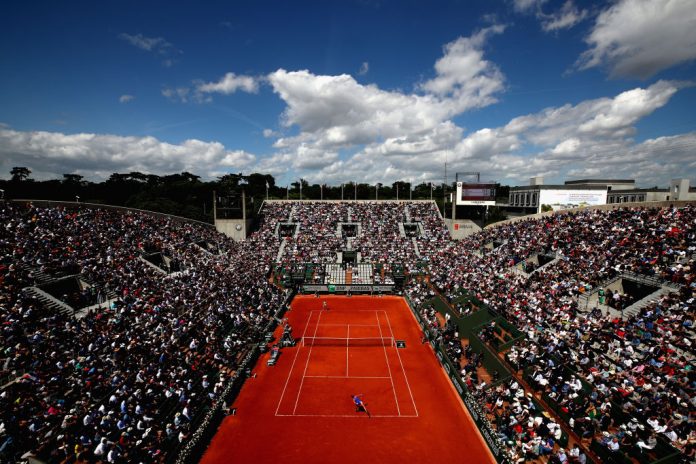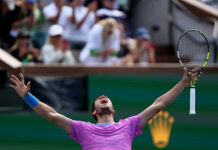By Michael Mewshaw
Plus ca change, as they say in Paris, the more things remain the same. Roland Garros is a great example of this truism. As it expands its grounds and adds new courts and facilities, a number of familiar landmarks will disappear. Court 1, often known as the Bullring, is due to fall to the wrecking ball. Court 7 has been replaced by an administrative edifice. But much of the distinctive French essence remains, starting with the ground under the players’ feet.
The red clay courts at Roland Garros are both famous and infamous. Famous for their rich terra cotta color, infamous for American players unaccustomed to the slow, slippery brick dust. Although there’s no evidence that the 19th century French writer Chateaubriand was a tennis fan, he might well have been describing the grueling progression of matches here when he remarked that while crimes are not always punished, mistakes are. Few points in Paris come easily. Most winning shots are the result of one player maneuvering another into a morale-killing, soul-destroying, body-sapping error.
As a fan, however, I love the clay court game with its emphasis on strategy and baroque geometry. I love the way that the players’ socks soon acquire a covering of brick dust, and their ankles end up looking as if they’ve been batter-fried. I love the way the groundskeepers break out hoses between sets and wet down the courts. This year as I sat in the scorching heat watching Frances Tiafoe struggle against Fabio Fognini, I was grateful that the groundskeeper graciously decided to cool down the crowd by flicking spray over the bleachers.
Of course high fashion is synonymous with Paris and the French Open is no exception to the rule that it’s as important to look good as to be good. Especially in the pricier seats on Courts Chatrier and Suzanne Lenglen, spectators look as though they have come straight from a diplomatic reception. Regardless of the weather, which can range from frigid to torrid, many men show up in dark suits, starched shirts and regimental ties. The women with them have that half-starved and enameled appearance of haute couture mannequins. Even the hired help is well turned out. Hostesses at the court entrances are decked out this year in cream-colored pleated frocks patterned after one of Suzanne Lenglen’s tennis outfits.
As always in France, high art retains primacy of place. Each year the tournament’s poster and its official tee shirt display the work of a celebrated artist. Many of the affiches from earlier decades have become collector’s items. Indeed, in 1989 when the Museum of Modern Art in New York mounted an exhibition entitled “The Modern Poster,” the catalogue cover reproduced a poster by A.M. Cassandre originally done for the 1932 French Open.
As someone whose first exposure to France came in 1968 when I was here as a Fulbright scholar, I love the nation’s obsession with its own lovely language. At other tournaments English is the lingua franca. Even in Uzbekistan the chair umpire called the score in English. Not in Paris, where even other commonplace terms of the game remain resolutely French. Topspin is referred to as lift (pronounced leafed), a tiebreak as a jeu decisif, an ace as un as, a dropshot as an amorti, and the net as le filet.
Years ago Mark Edmondson, a burly, combative Australian, grew furious when the umpire refused to give him the score in English. “Just tell me whether it’s my advantage or his,” Edmondson shouted. The umpire demonstrated complete incomprehension until Edmondson called him an arrogant pig – at which point the French umpire proved himself perfectly bilingual by slapping the Australian with a caution for verbal abuse.
Finally, however, art, fashion, red clay and linguistic pride give way to the ultimate national fetish – food! As Yannick Noah, the greatest French player of the Open era, once said during a press conference when asked about the empty bleachers during his lunchtime match, “The French like their tennis, but they love their cuisine even more.” Roland Garros boasts dozens of restaurants and private dining rooms, and on almost every court the aroma of roasting meat laces the air. The clink of silverware on china, of champagne corks popping and of waiters shouting orders often adds a curious undercurrent to the silence during the long hotly-contested points.
Fans who don’t care to waste time waiting for a table and eating a four-course lunch line up at booths that sell distinctively French dishes – crepes, gauffres, regional cheeses, and pan bagnat. In days of yore you could buy a hollowed-out baguette stuffed with a long sausage and doused in tart Dijon mustard. As journalist Curry Kirkpatrick quipped in Sports Illustrated, former French Open champion Adriano Panatta ate himself out of the top 10, so prodigious was his appetite for “les chiens chauds.” Some poetic souls may muse, “Ou sont les neiges d’antan?” – “Where are the snows of yesteryear?” But, for me, things are still dandy as long as there are pigs in a blanket at Roland Garros.
MICHAEL MEWSHAW is the author of 22 books. The most recent, AD IN AD OUT, a collection of his tennis essays, is now available online.



















